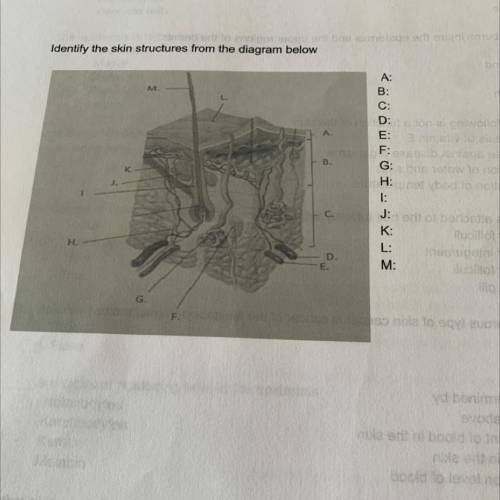Identify the skin structures from the diagram A-M
...

Answers: 3


Another question on Medicine

Medicine, 09.07.2019 19:10
An african american young adult is admitted to the emergency department in sickle cell crisis with a report of 10/10 pain. the patient is known to several of the nurses and physicians in the department who have labeled the patient as a “drug seeker”. initial discussion post: identify one (1) intervention that can be taken by the rn to reduce the stigma and improve management of acute and chronic pain associated with sickle cell disease. does the intervention apply only to the patient? does it apply only to the interprofessional team? does it apply to both the patient and the members of the interprofessional team? explain and support your answer.
Answers: 2

Medicine, 09.07.2019 19:10
Harold, a fifty-eight year old grocery store manager, had recently been waking up in the middle of the night with abdominal pain. this was happening several nights a week. he was also experiencing occasional discomfort in the middle of the afternoon. harold decided to schedule an appointment with his physician. the doctor listened as harold described his symptoms and then asked harold some questions. he noted that harold's appetite had suffered as a result of the pain he was experiencing and as a result of the fear that what he was eating may be responsible for the pain. otherwise, harold seemed fine. the doctor referred harold to a physician that specialized in internal medicine and had harold make an appointment for a procedure called an endoscopy. the endoscopy was performed at a hospital later that week. during the procedure, a long, thin tube was inserted into harold's mouth and directed into his digestive tract. the end of the tube was equipped with a light source and a small camera which allowed the doctor to observe the interior of harold's stomach. the endoscope was also equipped with a small claw-like structure that the doctor could use in order to obtain a small tissue sample from the lining of harold's stomach, if required. the endoscopy revealed that harold had a peptic ulcer. analysis of a tissue sample taken from the site showed that harold also had an infection that was caused by helicobacterpylori bacteria. the doctor who performed the endoscopy gave harold prescriptions for two different antibiotics and a medication that would decrease the secretion of stomach acid. the doctor also instructed harold to schedule an appointment for another endoscopy procedure in 6 months. 1. list the subjective findings in this case study. 2. what is an endoscopy? (2 points) what is a biopsy? 3. how was a biopsy performed on harold? 4. differentiate between gastric and duodenal ulcers by location. 5. what role does h. pylori play in the formation of peptic ulcers? 6. define occult and frank blood. (4 points) what is a guaiac test? 7. how can peptic ulcers cause bleeding? 8. why were antibiotics prescribed? 9. why would a medication that would decrease the secretion of stomach acid be beneficial?
Answers: 1

Medicine, 09.07.2019 19:10
Anurse is reviewing the medication administration record of a client who reports having a dry productive cough for the past 2 weeks. which of the following medications should the nurse report to the provider? a. furosemide b. lisinopril c. diltiazem d. metoprolol
Answers: 2

Medicine, 09.07.2019 20:10
Rita schmidt, 74 years of age, is a female patient who was admitted to the surgical unit after undergoing removal of a section of the colon for colorectal cancer. the patient does not have a colostomy. the patient has several small abdominal incisions and a clear dressing over each site. the incisions are well approximated and the staples are dry and intact. there is a jackson-pratt drain intact with minimal serous sanguineous drainage present. the patient has a salem sump tube connected to low continuous wall suction that is draining a small amount of brown liquid. the patient has no bowel sounds. the foley catheter has a small amount of dark amber-colored urine without sediments. the patient has sequential compression device (scd) in place. the nurse performs an assessment and that the patient's breath sounds are decreased bilaterally in the bases and the patient has inspiratory crackles. the patient's cardiac assessment is within normal limits. the patient is receiving o2 at 2 l per nasal hg; heart rate 110 bpm; respiratory rate 16 breaths/min; and the patient is afebrile. the patient is confused as to place and time. cannula with a pulse oximetry reading of 95%. the vital signs include: blood pressure, 100/50 mm. a. explain the assessment parameters used to provide clues to detect postoperative problems early and the interventions needed. b. what gerontological postoperative considerations should the nurse make?
Answers: 3
You know the right answer?
Questions

English, 03.01.2020 19:31

Chemistry, 03.01.2020 19:31

Social Studies, 03.01.2020 19:31



Social Studies, 03.01.2020 19:31

Social Studies, 03.01.2020 19:31




Social Studies, 03.01.2020 19:31



Mathematics, 03.01.2020 19:31



Mathematics, 03.01.2020 19:31


Business, 03.01.2020 19:31

English, 03.01.2020 19:31




